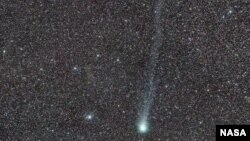There is a free cocktail party going on, but the only catch is you’ll need to get to the comet Lovejoy to partake.
Astronomers revealed that the comet is “releasing as much alcohol as in at least 500 bottles of wine every second during its peak activity," according to the Paris Observatory's Nicolas Biver, lead author of a paper on the discovery published Oct. 23 in Science Advances.
In addition to ethyl alcohol, the comet is also releasing glycolaldehyde, a simple sugar.
The discovery of the complex organic molecules give further credence to the theory that comets may be responsible for delivering the ingredients necessary for life.
"The result definitely promotes the idea the comets carry very complex chemistry," said Stefanie Milam of NASA's Goddard Space Flight Center in Greenbelt, Maryland, a co-author on the paper. "During the Late Heavy Bombardment about 3.8 billion years ago, when many comets and asteroids were blasting into Earth and we were getting our first oceans, life didn't have to start with just simple molecules like water, carbon monoxide, and nitrogen. Instead, life had something that was much more sophisticated on a molecular level.”
Comets are remnants from the formation of the solar system, and when their orbit brings them close to the sun they heat up and release gases, creating a dazzling light show.
When Lovejoy, formerly known as as C/2014 Q2, was nearest the sun on January 30 of this year it was releasing water at a rate of 20 tons per second, according to researchers.
By analyzing the molecules and how they glow at certain microwave frequencies scientists were able to determine the makeup of the molecules.
"The next step is to see if the organic material being found in comets came from the primordial cloud that formed the solar system or if it was created later on, inside the protoplanetary disk that surrounded the young sun," said Dominique Bockelée-Morvan from the Paris Observatory, a co-author of the paper.
Lovejoy Comet Releasing Massive Amounts of Alcohol
- By VOA News








